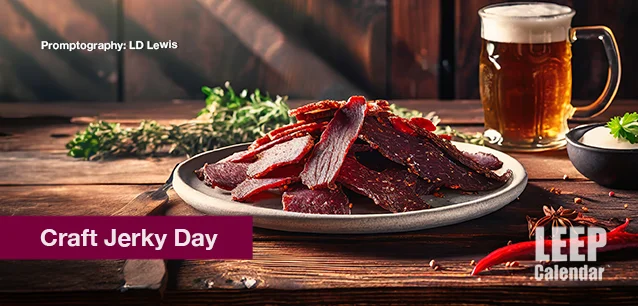 AD
AD
Today is: December 22
Scroll to explore events active on this date.
LEEP INK FEATURES

2025 is the Year of...
21 Themes and 'Year of' Events for 2025 PART ONE, THE FIRST 12 Every year, various organizations announce the theme for the year. These themes can focus on causes, such as aesthetics and color tre...

Nuanced November 2024
November is the start of the holiday season in many parts of the world. It is a time for family, football, food, shopping and decorating, particularly in the Christian and Jewish world, leading to Christmas and...

December's Gift
Events in December 2024. Well, we made it to December. December is the holiday season, particularly in Western nations, where Christianity and Judaism are the faiths most common in the nation's past. ...
About Craft Jerky Day
United States
Ends: Jan 01, 1970
DESCRIPTION:
Craft Jerky Day, initiated by the Long Beach Jerky Co., is celebrated annually on November 27th to honor the art and craft of making jerky. Jerky is an ancient culinary technique for preserving meat. This observance highlights the growing craft jerky industry, emphasizing the quality, creativity, and traditional methods of producing artisanal jerky.
Artisan jerky makers nationwide participate by offering special deals, introducing new flavors, and hosting events to educate consumers about the differences between mass-produced jerky and handcrafted, small-batch products.
WHAT IS JERKY?
Jerky, a form of dried meat that has been a staple in various cultures for centuries, has a rich history rooted in the need for preserving meat in a time before refrigeration. Making jerky involves removing the fat from meat, cutting it into thin strips, and then drying it to prevent spoilage.
The origins of jerky are believed to date back to ancient Egypt. Dried meats were included with the dead to aid their journey to the afterlife. However, the term "jerky" itself comes from the Quechua word "ch'arki," which means "dried, salted meat." This technique was used by the indigenous peoples of South America, notably the Inca Empire, where llamas and alpacas were dried and smoked.
In North America, Native Americans developed their method of making jerky from game animals like deer, elk, and buffalo. The meat was cut into thin strips, defatted, and dried over a fire or in the hot sun, often after being treated with salt or smoked. This process made the meat last for extended periods, providing a vital source of protein during long journeys or when fresh meat was unavailable.
European explorers and settlers adopted jerky-making methods from Native Americans, integrating them into their food preservation practices. Jerky became a valuable resource for explorers, traders, and settlers, especially as they moved westward across the North American continent.
The traditional process of making jerky starts with slicing the meat into thin strips, which allows it to dry evenly. The meat is then typically marinated with a mixture of seasonings, salt, and sometimes sugar to add flavor and aid preservation. After marinating, the meat is dried using a dehydrator, smoker, oven, or air-drying in the sun, depending on available resources and the desired flavor profile.
Modern jerky production has evolved with technology but still follows the basic principles of the traditional method. Commercial manufacturers use controlled environments for drying and may add preservatives to extend shelf life. The variety of meats used for jerky has also expanded beyond traditional beef to include poultry, pork, and exotic meats like kangaroo or ostrich.
VIDEOS
SUPPORTING DOCUMENTS
Currently, this event does not have supporting documents.
ADDITIONAL IMAGES
Currently, this event does not have supporting images.
Where would you like to go now?
 AD
AD


/footer-logo.svg)
